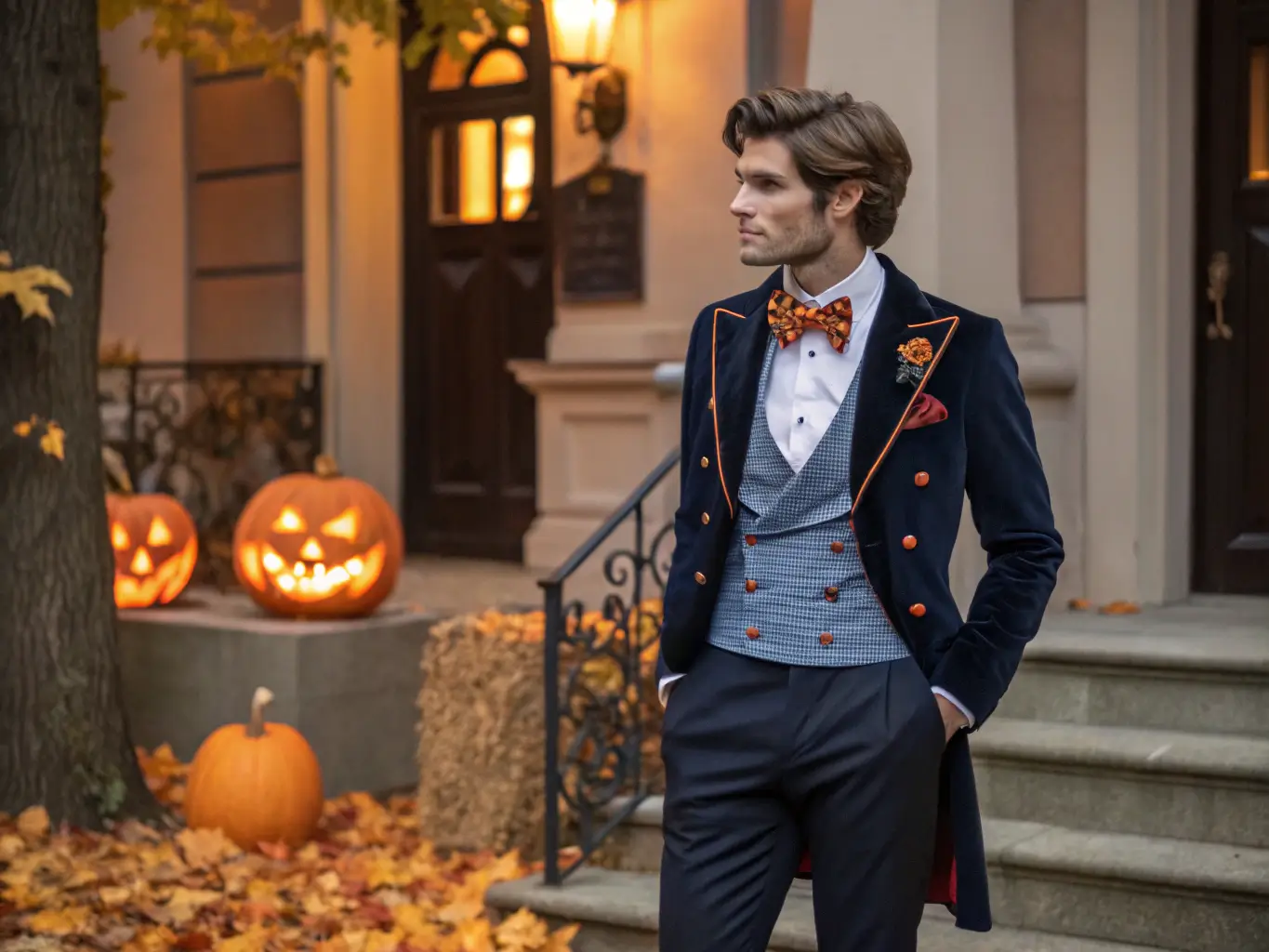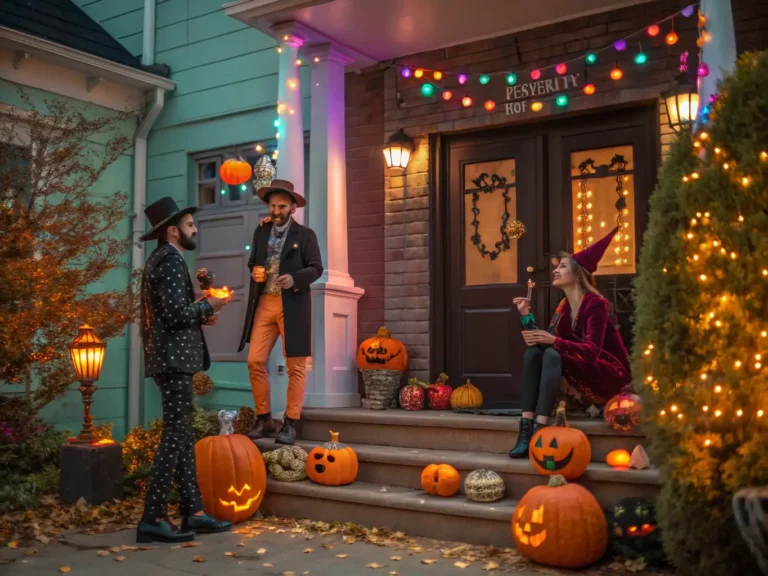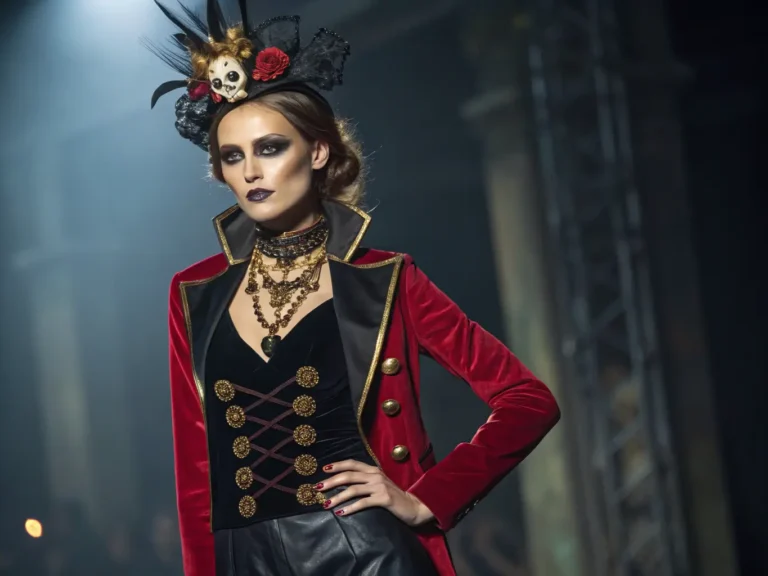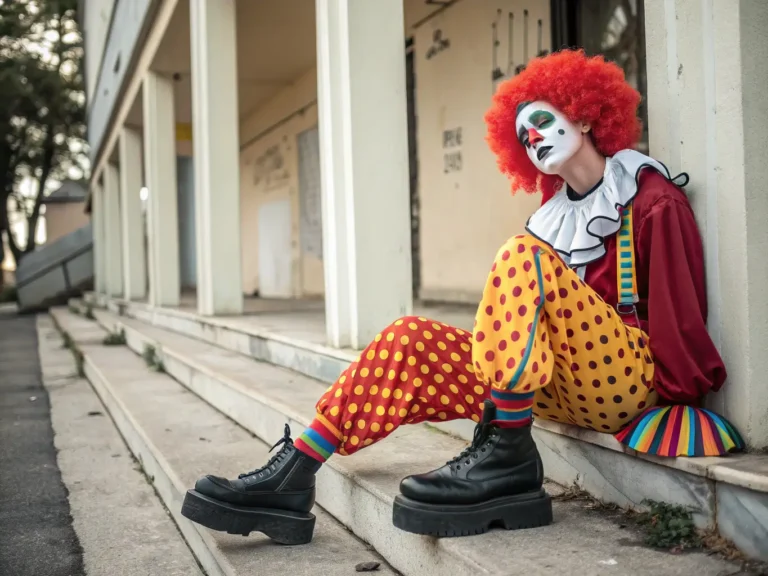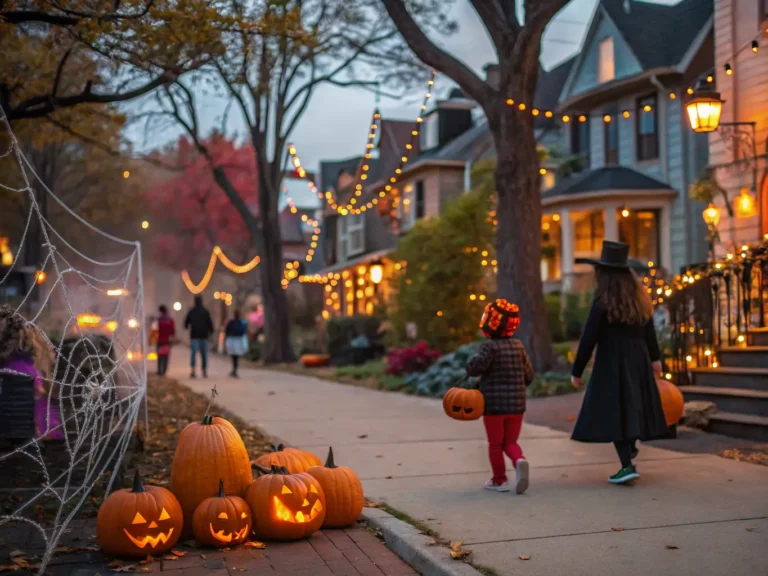Step-by-Step Guide to DIY Halloween Costume
As Halloween costumes approaches, many of us are on the lookout for the perfect costume. Instead of breaking the bank or settling for a generic store-bought option, consider creating your own DIY Halloween masterpiece.

With a little creativity and some basic crafting supplies, you can create a unique and personalized DIY Halloween costume that showcases your individuality. This guide will walk you through the process, providing step-by-step instructions and inspiration to help you bring your costume ideas to life.
Key Takeaways
- Create a unique DIY Halloween costume with minimal expense.
- Follow step-by-step instructions for a stress-free crafting experience.
- Unleash your creativity and personalize your costume.
- Learn various crafting techniques to enhance your DIY skills.
- Get inspired by creative ideas and themes for your Halloween costume.
Table of Contents
Planning Your Perfect Halloween Costume
A great Halloween costume starts with a solid plan, especially for DIY enthusiasts. Planning your costume early allows you to gather materials, work on details, and avoid last-minute rushes. As “The night is dark, and full of terrors,” but with a good plan, your Halloween will be filled with joy, not stress.
Finding Inspiration for Your DIY Creation
Finding the right inspiration is crucial for a DIY Halloween costume. Inspiration can come from various sources, including popular culture and classic Halloween characters.
Popular Culture References and Trends
Popular culture is a rich source of inspiration. Look at the latest movies, TV shows, and video games for character ideas. For instance, characters from Stranger Things or Game of Thrones are always in vogue. You can also draw inspiration from trending memes and social media challenges.
Classic Halloween Characters Reimagined
Classic characters like vampires, werewolves, and witches are timeless. You can put a modern twist on these characters to make them more interesting. For example, a steampunk vampire or a cyberpunk witch can be a unique take on traditional Halloween characters.
Assessing Your Skill Level and Time Commitment
Before diving into your DIY project, it’s essential to assess your skill level and the time you can commit. This assessment will help you choose a project that’s both fun and feasible.
Beginner-Friendly Costume Ideas
If you’re new to DIY costumes, start with simple ideas. You can create a ghost, a pirate, or a basic superhero costume with minimal materials and effort. These costumes are great for beginners and can be made quickly.
Planning Your Costume Timeline
Create a timeline for your costume-making process. Decide on the materials you need, the steps involved, and the deadline for completion. Having a plan will make the process less overwhelming and more enjoyable.
Budget-Friendly Costume Planning
You can create an amazing Halloween costume without overspending. The key is in the planning. By setting a realistic budget and employing cost-saving strategies, you can craft a costume that’s both impressive and affordable.
Setting a Realistic Costume Budget
Before starting your DIY Halloween costume project, it’s essential to determine how much you’re willing to spend. Consider the materials you already have at home and the cost of any additional supplies you might need. A well-planned budget helps you stay on track and avoid last-minute, costly decisions.
Cost-Saving Strategies for Materials
There are several ways to save money on costume materials. Two effective methods include thrift store shopping and upcycling household items.
Thrift Store Treasure Hunting
Thrift stores are treasure troves for unique, affordable pieces that can be repurposed for your costume. Keep an open mind, and you might find a hidden gem that adds a special touch to your DIY creation.
Upcycling Household Items
Look around your home for items that can be creatively repurposed. Old clothes, cardboard, and fabric scraps can become integral parts of your costume. This approach not only saves money but also reduces waste.
| Cost-Saving Strategy | Description | Potential Savings |
|---|---|---|
| Thrift Store Shopping | Finding unique, second-hand items for your costume | Up to 50% off new retail prices |
| Upcycling Household Items | Repurposing items you already own for your costume | 100% savings, as you’re using what you already have |
By implementing these budget-friendly strategies, you can create a Halloween costume that’s both impressive and affordable. With a little creativity and planning, you’ll be the envy of the party without breaking the bank.
Essential Materials for DIY Costume Halloween Projects
When it comes to creating a DIY Halloween costume, having the right materials is crucial. The success of your project depends on the quality and suitability of the materials you choose.
Basic Supplies Every Costume Maker Needs
To start your DIY costume project, you’ll need some basic supplies. These include:
- Scissors
- Glue or hot glue gun
- Needle and thread
- Measuring tape
- Cardboard or cardstock
Fabric and Material Options
Choosing the right fabric is essential for your DIY costume. Consider using cotton, polyester, or felt, depending on the costume design. You can also repurpose old clothes or fabric scraps to create unique textures.
Adhesives, Fasteners, and Structural Elements
In addition to fabric, you’ll need adhesives, fasteners, and structural elements to bring your costume to life. Use hot glue for sturdy bonds, Velcro for easy fastening, and wire or cardboard to add structure to your costume.
Where to Find Affordable Materials
Finding affordable materials is key to staying within your budget. Consider shopping at:
- Craft stores like Michaels or Hobby Lobby
- Online retailers like Amazon or eBay
- Thrift stores or second-hand shops
Online Resources for Specialty Items
For specialty items, try online resources like Etsy or Amazon. These platforms offer a wide range of unique materials and supplies.
Craft Store Shopping Strategies
When shopping at craft stores, look for sales or discounts on materials. Consider buying in bulk or using coupons to save money.
Tools and Techniques for Costume Creation
The art of costume creation involves mastering various techniques, from no-sew methods to basic sewing skills. Whether you’re a beginner or an experienced crafter, understanding these tools and techniques is crucial for bringing your DIY Halloween costume to life.
No-Sew Methods for Beginners
No-sew methods are perfect for those who are new to costume making or don’t have access to a sewing machine. These techniques can be just as effective and creative.
Fabric Glue and Tape Techniques
Fabric glue and tape are excellent for bonding fabrics without sewing. Hot glue guns can be used for more durable attachments, while fabric tape is great for temporary fixes or adjustments.
Safety Pin and Velcro Assembly
Safety pins and Velcro are simple yet effective fastening methods. They allow for easy adjustments and can be used to secure various parts of your costume together.

Basic Sewing Skills for Costume Making
For those willing to take their costume making to the next level, basic sewing skills are indispensable. They offer more durability and flexibility in your creations.
Hand-Stitching Essentials
Hand-stitching is a fundamental skill that allows for precise control over your costume’s details. It’s particularly useful for delicate or intricate parts.
Simple Machine Sewing Projects
Using a sewing machine can significantly speed up your costume making process. Simple projects like hemming pants or sewing straight seams are great for beginners.
By mastering both no-sew methods and basic sewing skills, you can create a wide range of DIY Halloween costumes that are both creative and well-made.
Creating Character-Based Costumes
Whether you’re a fan of superheroes or movie characters, making your own Halloween costume is a great way to show your fandom. Character-based costumes allow you to embody your favorite heroes or villains, making the Halloween experience more immersive and fun.
Superhero Costume Construction
Superhero costumes are a popular choice for Halloween. To create a convincing superhero costume, you’ll need to focus on the details that make the character recognizable.
Creating Emblems and Logos
Emblems and logos are crucial elements of superhero costumes. You can create these using fabric paint, felt, or even 3D printing for more complex designs. Accuracy is key to ensuring your costume is recognizable.
Crafting Masks and Headpieces
Masks and headpieces can be made using various materials like latex, fabric, or cardboard. For a more professional look, consider using a combination of these materials. Pay attention to comfort as well, since you’ll be wearing this for several hours.
Movie and TV Character Transformations
Transforming into a movie or TV character requires capturing the essence of that character. This involves identifying the signature elements that make the character recognizable.
Identifying Signature Character Elements
Start by researching your character’s appearance in the movie or TV show. Look for distinctive clothing, accessories, or makeup. Make a list of these elements to guide your costume creation.
Adapting Complex Designs for DIY
Some character designs may seem too complex for a DIY project. However, with some creativity, you can simplify these designs. For example, you can use fabric paint to replicate intricate patterns or substitute complex accessories with simpler versions.
Crafting Spooky and Classic Halloween Costumes
Creating a classic Halloween costume is an art that requires some creativity and skill. Halloween enthusiasts often look for inspiration from traditional monsters and supernatural beings, which have been the cornerstone of Halloween celebrations for decades.
Traditional Monster Costumes
Traditional monster costumes, such as vampires and werewolves, are staples of Halloween. These characters have been frightening and fascinating people for generations.
Vampire Cape and Collar Construction
A vampire costume isn’t complete without a cape and collar. To create a vampire cape, you’ll need black fabric, scissors, and a needle and thread. You can add a dramatic touch with a red lining or accents. The collar can be made from a stiff material and attached to a velvet or satin band around the neck.
Werewolf Fur and Claw Techniques
Werewolf costumes require fake fur and claws to give them a menacing appearance. You can use fabric paint or makeup to create a furry effect on clothing, or attach fake fur pieces. Claws can be made from cardboard, foam, or even 3D printed for a more realistic look.
Ghost, Witch, and Skeleton Basics
Other classic Halloween characters include ghosts, witches, and skeletons. These costumes are relatively easy to create and require minimal materials.
Sheet Ghost Upgrades
A simple ghost costume can be elevated by adding some creative touches, such as glowing eyes or a more defined shape under the sheet. You can use glow sticks or EL wire to create an eerie glow.
Witch Hat and Broom Crafting
Witch hats can be made from black felt or cardboard, shaped into a cone or a wide-brimmed hat. Adding a band or ribbon can give it a personalized touch. A broom can be crafted from a wooden dowel and bristles made from twine or fabric strips.

Quick and Easy Last-Minute Costume Ideas
Creating a great Halloween costume at the last minute is easier than you think. With a little creativity and some quick thinking, you can come up with a costume that’s both impressive and fun. Here are some ideas to get you started.
One-Hour Costume Solutions
When time is of the essence, focus on simple yet effective costume ideas. You can create a costume in under an hour with the right materials and a bit of inspiration.
T-Shirt Based Costumes
One of the quickest ways to create a costume is by using a T-shirt as the base. You can turn a plain T-shirt into a superhero logo or a fun design with some fabric paint or iron-on transfers. Add some simple accessories, and you’re ready to go.
Simple Prop-Based Characters
Props can instantly elevate a costume. For example, carrying a fake sword and wearing a cape can make you a knight or a superhero. You can also use props to represent characters from your favorite movies or TV shows.
Using Items You Already Have at Home
Before you rush out to buy costume pieces, look around your house for items you can repurpose. This not only saves time but also money.
Closet Costuming Techniques
Your closet is a treasure trove of potential costume pieces. Use old clothes to create a retro look or mix and match different items to come up with something entirely new. A little creativity can go a long way.
Household Object Transformations
Common household items can be transformed into unique costume elements. For instance, a cardboard box can become a robot’s chest piece, or a kitchen colander can turn into a futuristic helmet. The possibilities are endless.
With these quick and easy last-minute costume ideas, you can have a fantastic Halloween costume without the last-minute stress. Get creative, and have fun!
Elevating Your Costume with Props and Accessories
To take your Halloween costume to the next level, consider adding props and accessories that enhance your overall look. Props and accessories can significantly impact the authenticity and appeal of your costume, making it stand out at any Halloween gathering.
DIY Weapons and Magical Items
Creating your own DIY weapons and magical items can be a fun and creative process. You can use various materials like foam, cardboard, or even 3D printing to create these items.
Foam and Cardboard Construction Methods
Foam and cardboard are versatile materials for crafting props. For instance, you can create a sword using foam by cutting out the shape, sanding it, and then painting it. Cardboard can be used similarly, though it may require additional reinforcement for durability.
Safe Prop Design Considerations
When designing props, especially weapons, safety should be a top priority. Ensure that your props are not sharp or heavy and are designed in a way that they won’t cause accidental harm to yourself or others.
Creating Costume-Specific Accessories
Accessories such as jewelry, footwear, and gloves can greatly enhance your costume. You can either buy these items or make them yourself, depending on your skill level and the desired level of customization.
Jewelry and Small Accessories
For jewelry and small accessories, you can use materials like beads, fabric, or metal. Creating custom jewelry that matches your character’s can add a unique touch to your costume.
Footwear and Glove Modifications
Modifying your footwear and gloves to match your costume can be as simple as painting them or as complex as crafting entirely new pieces. For example, adding fabric or foam details to boots can transform them into character-specific footwear.
| Accessory | Materials | Skill Level |
|---|---|---|
| Jewelry | Beads, fabric, metal | Beginner |
| Footwear Modifications | Paint, fabric, foam | Intermediate |
| Gloves | Fabric, leather, paint | Beginner |
Makeup and Special Effects for Halloween
Makeup and special effects are the keys to unlocking a truly unforgettable Halloween character. Whether you’re aiming for a terrifying monster or a mystical creature, the right makeup techniques can make all the difference.
Basic Face Painting Techniques
Face painting is a fundamental skill for any Halloween enthusiast. It involves applying makeup to create various designs or characters on the face.
Color Selection and Application
Choosing the right colors is crucial for achieving the desired effect. Select colors that complement your skin tone and the character you’re portraying. Apply the makeup smoothly and evenly to avoid any harsh lines.
Setting and Preserving Your Makeup
To ensure your makeup lasts throughout the night, set it with a setting spray. This helps prevent smudging and fading, keeping your look intact for hours.
Creating Wounds and Scars
For a more gruesome or horror-themed look, creating wounds and scars can be particularly effective. This involves using various materials and techniques to create realistic effects.
Latex and Wax Applications
Latex and wax are commonly used to create prosthetic pieces that can be applied to the skin to create wounds or scars. Apply a small amount of adhesive to secure the piece in place.
Blood and Gore Effects
To add a realistic touch, use special effects blood to create a gore effect. This can be applied using a brush or sponge to achieve the desired level of realism.
Full-Face Character Transformations
For a complete transformation, consider using contouring and prosthetics to change your entire appearance.
Contouring for Character Features
Contouring involves using makeup to highlight and shadow areas of the face, creating the illusion of different facial structures. Use a darker shade to create shadows and a lighter shade to highlight.
Working with Prosthetics
Prosthetics can be used to create more dramatic changes, such as altering the shape of your nose, adding horns, or changing the contours of your face. Apply prosthetic pieces using adhesive and blend the edges for a seamless look.
By mastering these makeup and special effects techniques, you can create a truly unforgettable Halloween character that will leave a lasting impression on those around you.
- Practice your makeup skills before Halloween to achieve the best results.
- Use high-quality makeup products to ensure durability and realism.
- Experiment with different techniques and materials to find what works best for you.
Conclusion
With these steps and tips, you’re well on your way to creating a fantastic DIY Halloween costume. From planning and budgeting to crafting and accessorizing, this guide has covered the essentials to make your Halloween celebration unforgettable.
As you bring your costume to life, remember to have fun and be creative. Whether you’re a seasoned crafter or a beginner, the joy of making something with your own hands is a big part of the Halloween spirit. So, get crafting, and don’t be afraid to experiment with new ideas and techniques.
By following this DIY guide, you’ll not only save money and create a unique costume but also enjoy the process of making something special. Happy crafting, and have a spook-tacular Halloween!
FAQ
What are some popular DIY Halloween costume ideas?
Some popular DIY Halloween costume ideas include superheroes, movie and TV characters, and classic Halloween characters like vampires, werewolves, and witches. You can also create a costume based on a character from a book or video game.
How do I choose a DIY Halloween costume that fits my skill level?
To choose a DIY Halloween costume that fits your skill level, consider the complexity of the design, the materials needed, and the time required to complete the costume. If you’re a beginner, start with a simple design and work your way up to more complex projects.
What are some budget-friendly materials for DIY Halloween costumes?
Some budget-friendly materials for DIY Halloween costumes include thrift store finds, household items, fabric scraps, and cardboard. You can also repurpose old clothes and accessories to create a unique and affordable costume.
How can I make a DIY Halloween costume more convincing with makeup and special effects?
To make a DIY Halloween costume more convincing with makeup and special effects, use techniques like face painting, contouring, and prosthetics. You can also add wounds, scars, and other effects to enhance the overall look of the costume.
What are some tips for creating a DIY Halloween costume with no sewing required?
To create a DIY Halloween costume with no sewing required, use no-sew methods like fabric glue, tape, safety pins, and Velcro. You can also use pre-made accessories and props to complete the look.
How can I make a DIY Halloween costume for a last-minute party or event?
To make a DIY Halloween costume for a last-minute party or event, use quick and easy ideas like T-shirt based costumes, simple prop-based characters, or closet costuming techniques. You can also repurpose items you already have at home to create a unique and creative costume.
What are some safety considerations when creating a DIY Halloween costume?
When creating a DIY Halloween costume, consider safety factors like visibility, mobility, and potential allergens or irritants. Make sure the costume is well-lit and visible, and avoid using materials that may cause skin irritation or allergic reactions.
How can I store and reuse my DIY Halloween costume for future events?
To store and reuse your DIY Halloween costume, carefully clean and dry the costume, then store it in a cool, dry place. Consider using storage containers or bags to keep the costume clean and protected. You can also repurpose or upcycle the costume into a new creation for future events.

